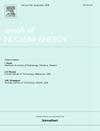改进有关铀和锆相分配的腔内铈瞬态分层模型
IF 1.9
3区 工程技术
Q1 NUCLEAR SCIENCE & TECHNOLOGY
引用次数: 0
摘要
容器内熔体滞留(IVR)缓解策略的主要威胁之一是容器下端液体堆芯的瞬态热化学分层。本文提出改进{U,O,Zr,Steel}体系在混相间隙内的瞬态液相分层模型。这项工作是对先前模型的补充,考虑了重定位过程中金属液滴的形成,这里的重点是通过单独处理铀和锆而不是作为伪成分来改进传质模型。这意味着在这里提出的模型中,铀对锆的摩尔比在氧化物和金属相中是不相等的。给出了该模型的方程及其所需的热力学闭包。解离铀和锆的转移允许使用热力学闭包,这更接近使用吉布斯能量最小化器计算的实际热力学状态。将改进的模型应用于一个合成瞬态,其中金属被添加到氧化相的顶部,导致平衡状态与重金属层的产生。对该合成瞬态进行进一步修正,达到分层反演。结果与以前的模型进行了比较,表明在计算瞬态分层方面有了显著的改进。本文章由计算机程序翻译,如有差异,请以英文原文为准。
Improvement of in-vessel corium transient stratification modelling regarding the uranium and zirconium phase partitioning
One of the main threats on In-Vessel Melt Retention (IVR) mitigation strategy is the transient thermochemical stratification of the liquid corium in the vessel lowerhead. This paper proposes to improve the modelling of the transient liquid phase stratification of the {U,O,Zr,Steel} system within its miscibility gap. This work is an increment on a previous model considering the metal droplet forming during the relocation, and the focus is here on improving the mass transfer modelling by treating Uranium and Zirconium separately and not as a pseudo component. This means that in the model presented here the molar ratio of Uranium over Zirconium is not equal in the oxide and in the metallic phase.
The equations of the model are presented as well as the thermodynamic closures it requires. Dissociating the transfers of Uranium and Zirconium allows for the use of thermodynamic closures that are closer to the actual thermodynamic state calculated using a Gibbs Energy minimizer.
The improved model is applied to a synthetic transient where metal is added on top of an oxide phase leading to an equilibrium state with heavy metal layer creation. This synthetic transient is further modified to reach stratification inversion. The results are compared to the previous model and show significant improvements in computing the transient stratification.
求助全文
通过发布文献求助,成功后即可免费获取论文全文。
去求助
来源期刊

Annals of Nuclear Energy
工程技术-核科学技术
CiteScore
4.30
自引率
21.10%
发文量
632
审稿时长
7.3 months
期刊介绍:
Annals of Nuclear Energy provides an international medium for the communication of original research, ideas and developments in all areas of the field of nuclear energy science and technology. Its scope embraces nuclear fuel reserves, fuel cycles and cost, materials, processing, system and component technology (fission only), design and optimization, direct conversion of nuclear energy sources, environmental control, reactor physics, heat transfer and fluid dynamics, structural analysis, fuel management, future developments, nuclear fuel and safety, nuclear aerosol, neutron physics, computer technology (both software and hardware), risk assessment, radioactive waste disposal and reactor thermal hydraulics. Papers submitted to Annals need to demonstrate a clear link to nuclear power generation/nuclear engineering. Papers which deal with pure nuclear physics, pure health physics, imaging, or attenuation and shielding properties of concretes and various geological materials are not within the scope of the journal. Also, papers that deal with policy or economics are not within the scope of the journal.
 求助内容:
求助内容: 应助结果提醒方式:
应助结果提醒方式:


